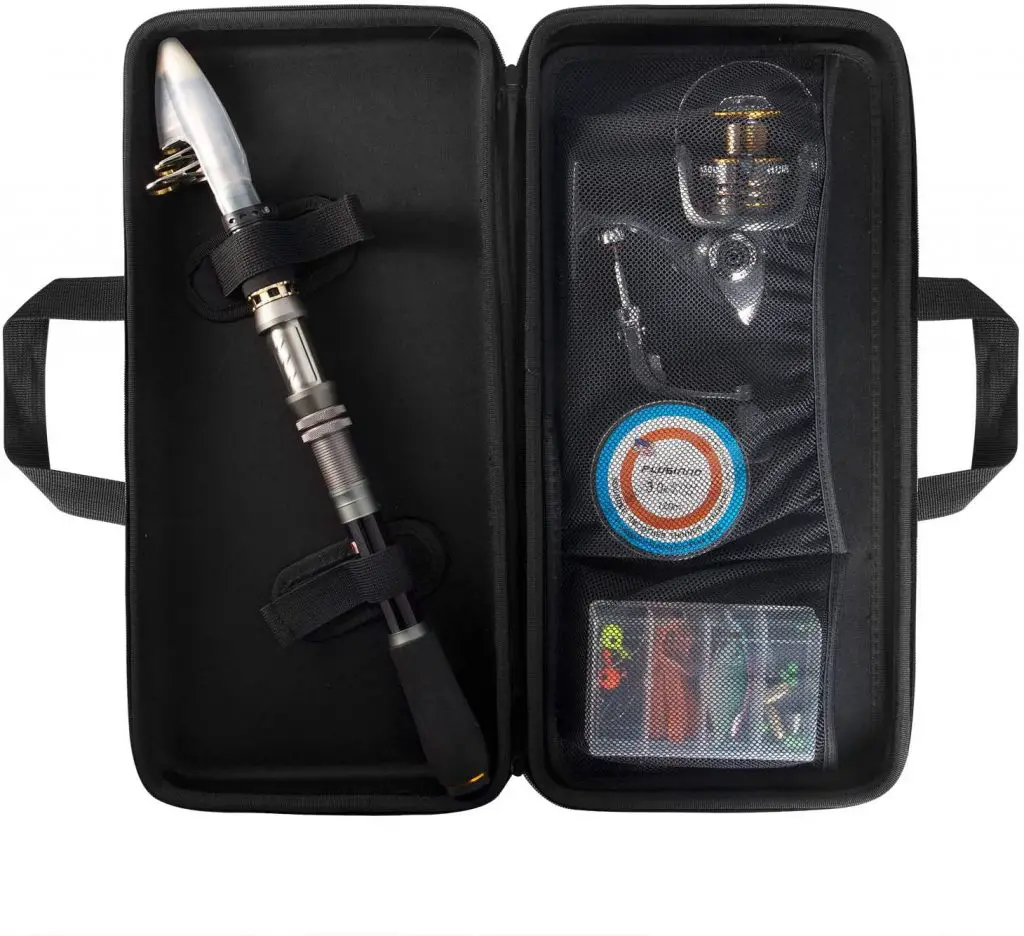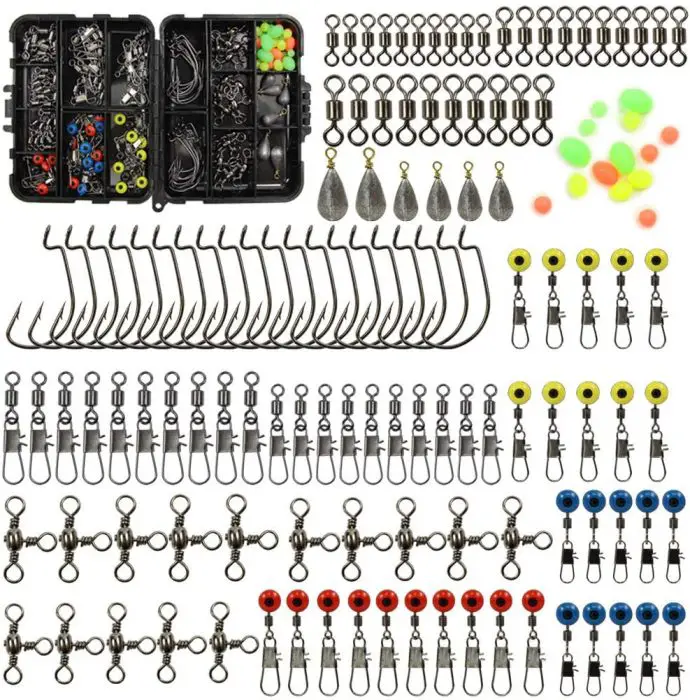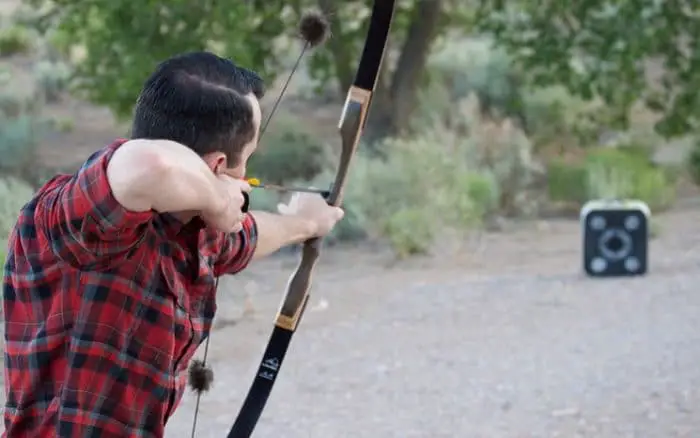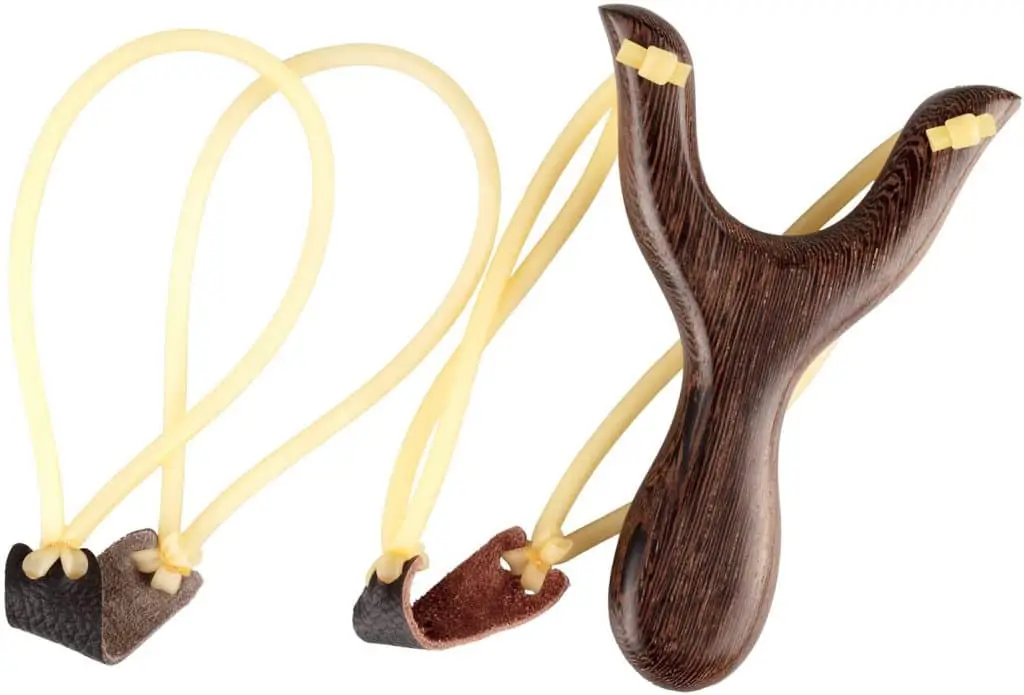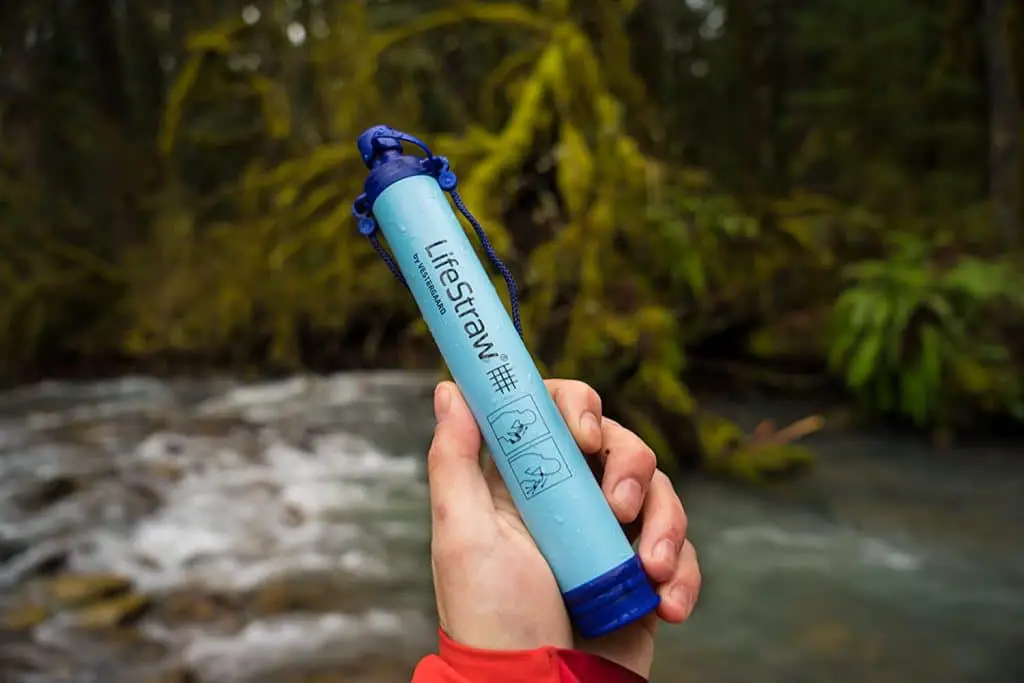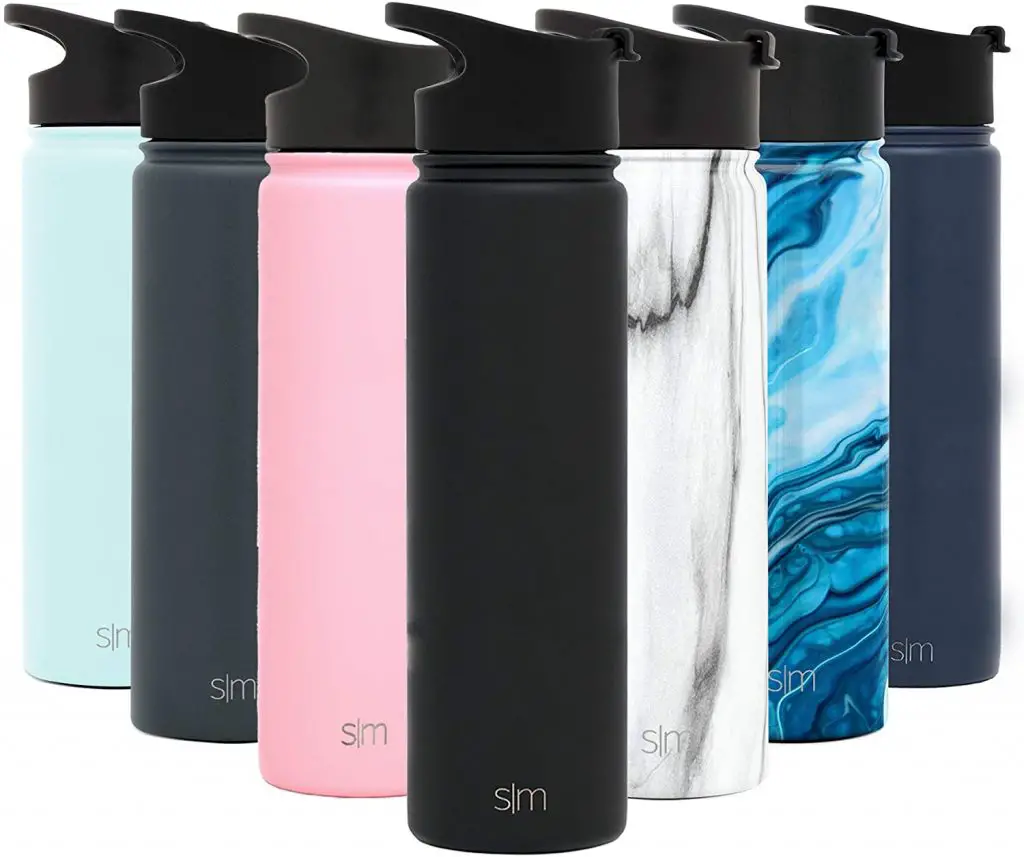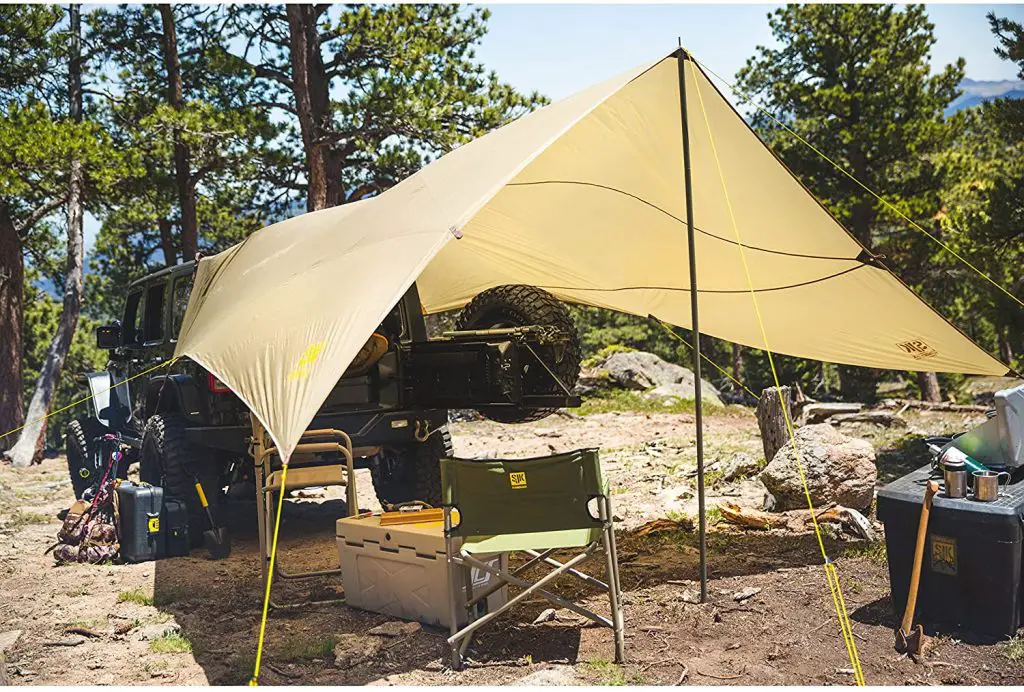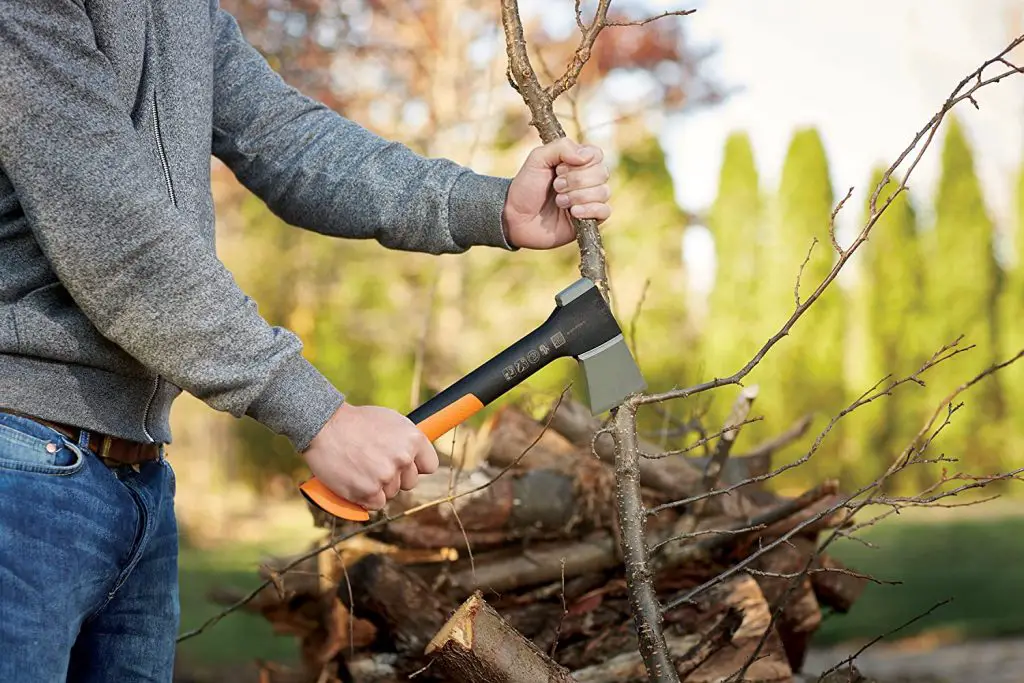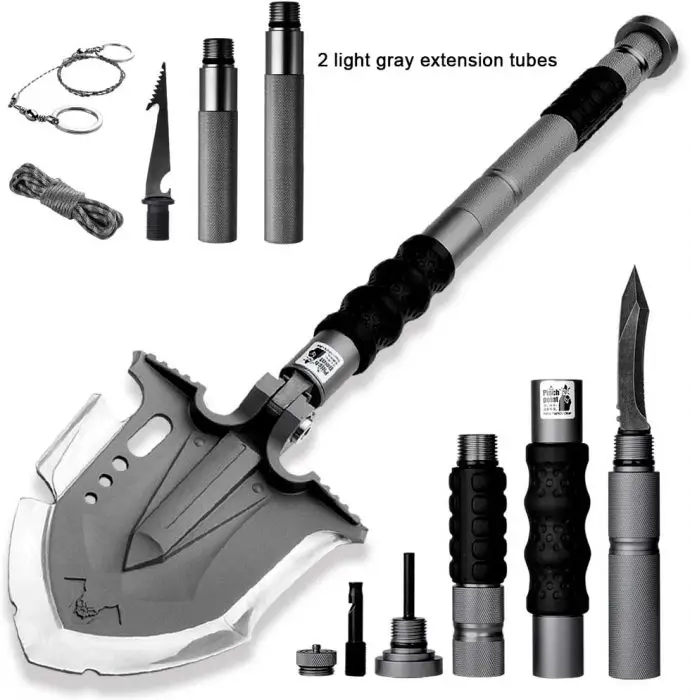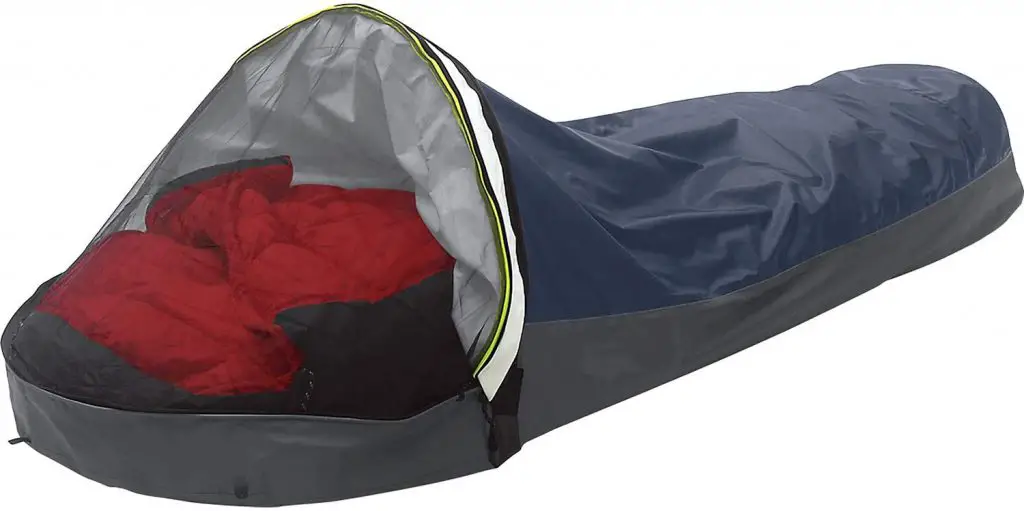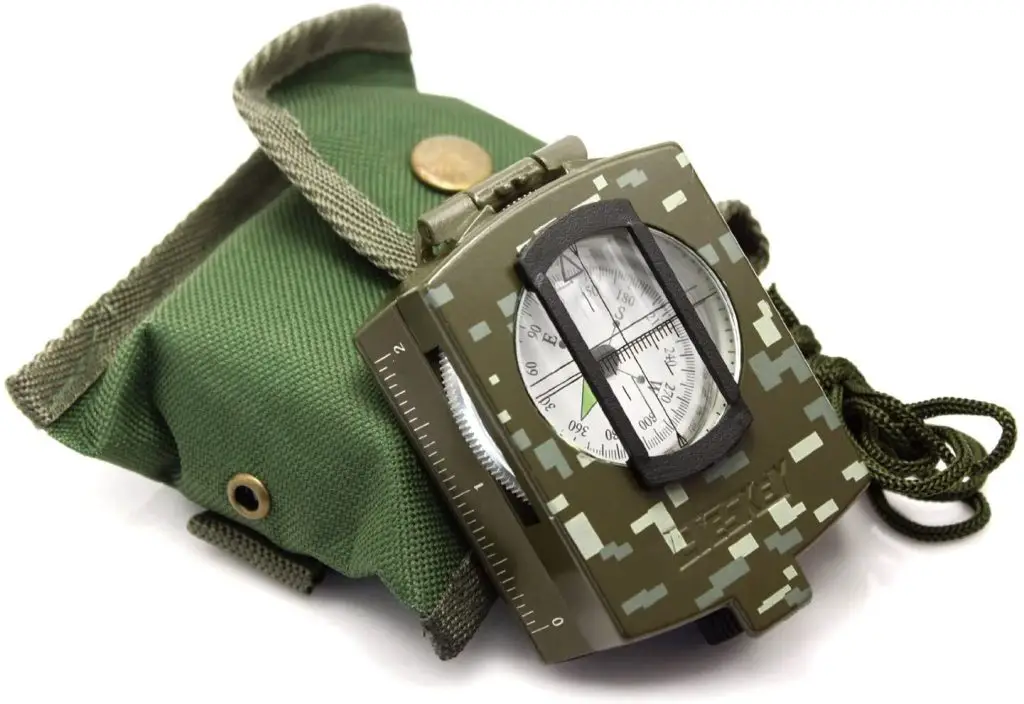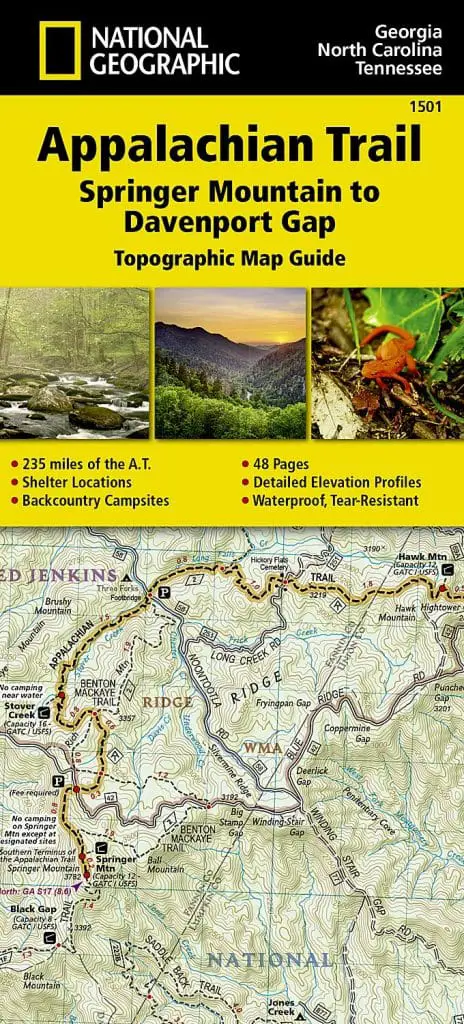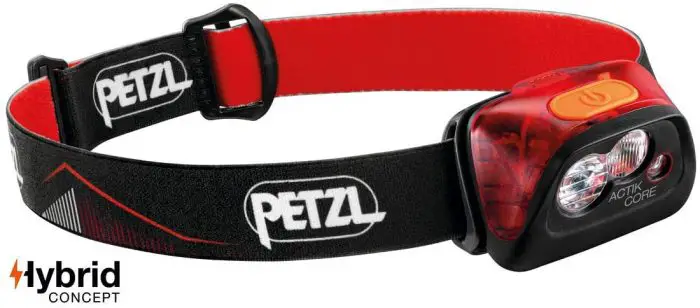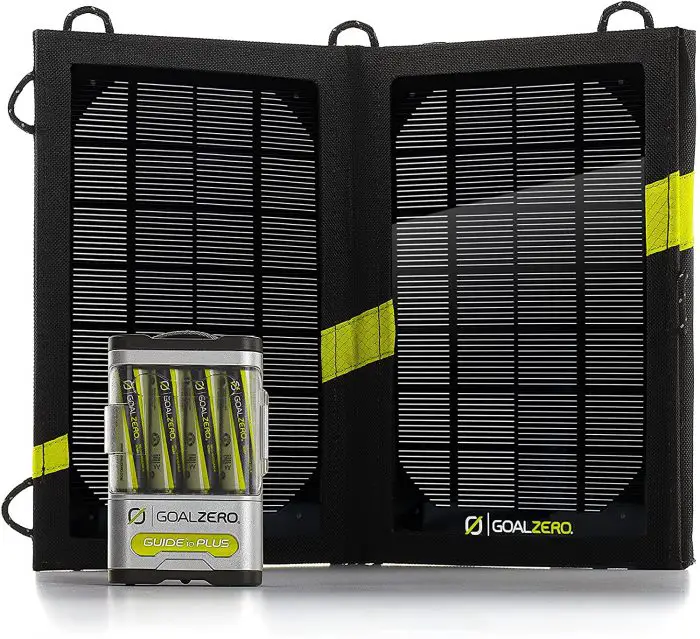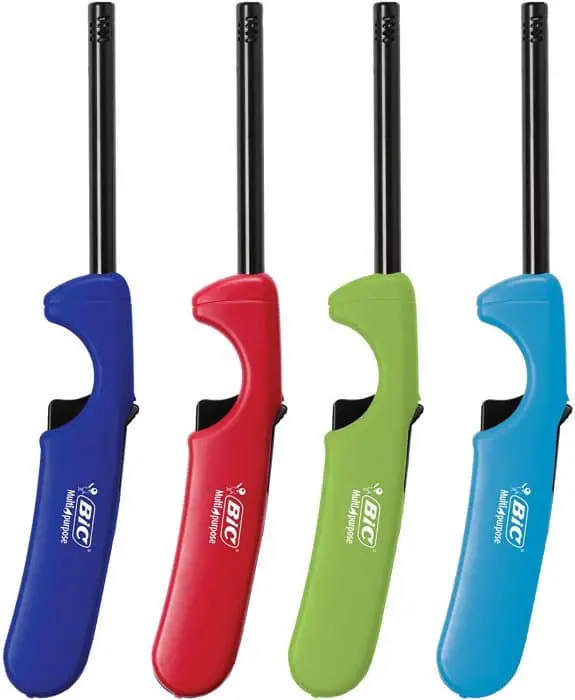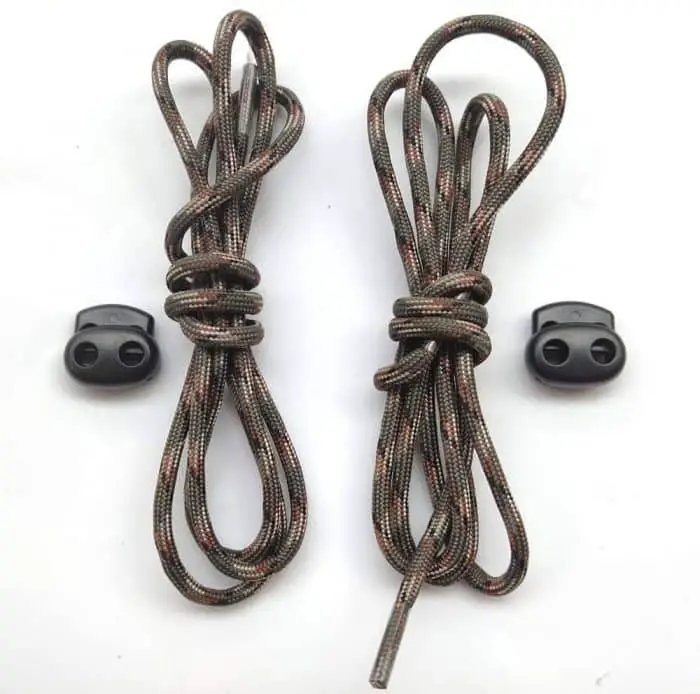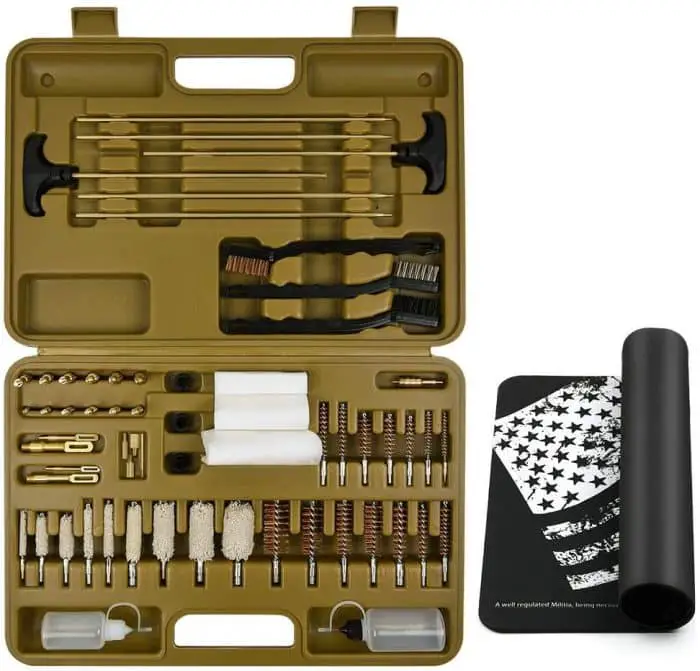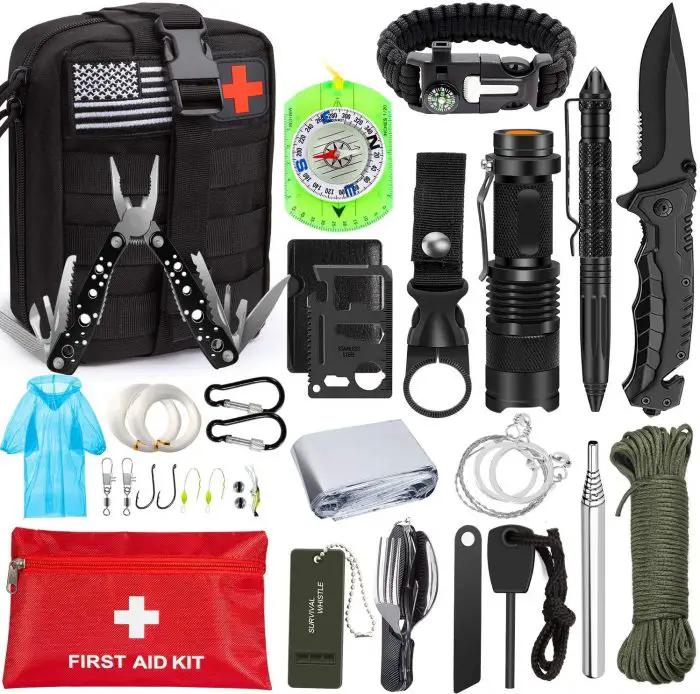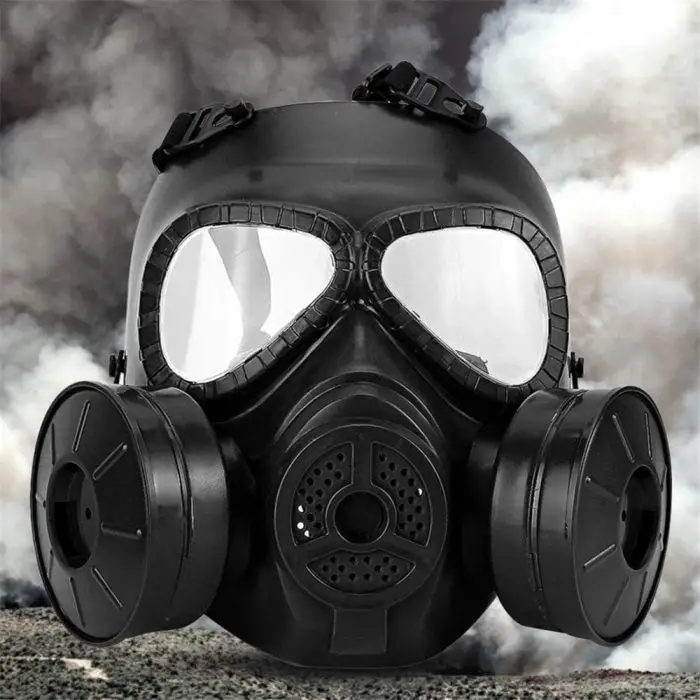In case you didn’t know, “INCH” in INCH Bag stands for “I’m Never Coming Home.”
They are bigger and contain more supplies than your bug out bags because they are meant to make you survive for an extended period.
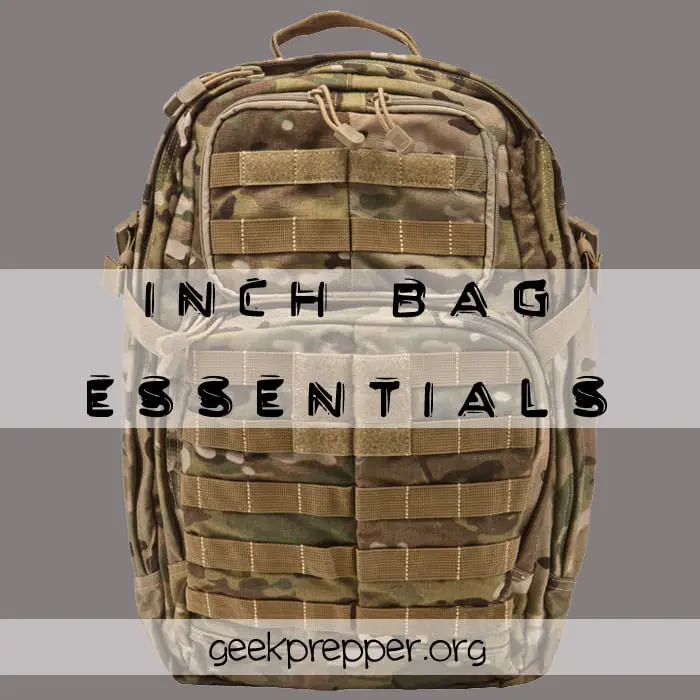
Bug out Bag vs. INCH Bag
A bug out bag is perfect for shorter periods, while an INCH Bag is necessary if you plan to be out in the wilderness for months or years.
Since INCH bags are supposed to last longer, you might think that you need to pack more. However, that is not always the case.
How to Build an Inch Bag
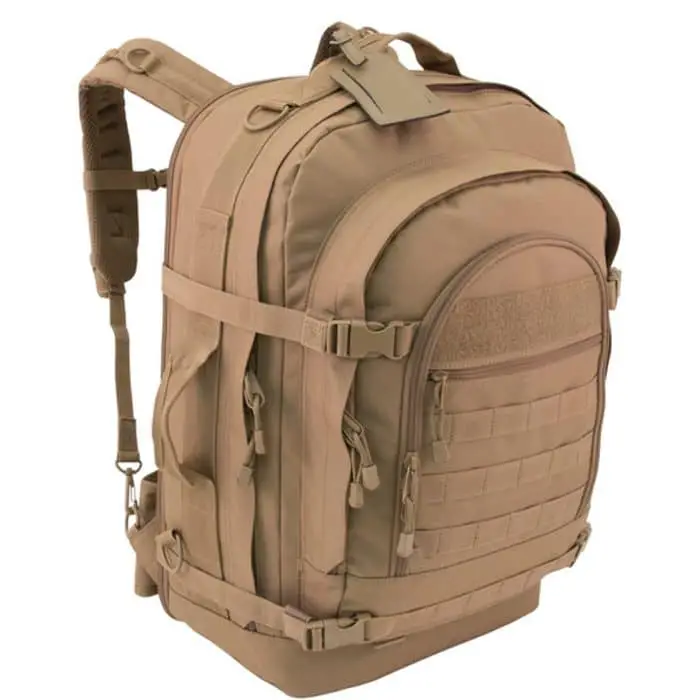
INCH bags aren’t just about packing more. In addition to adding more food, water, clothes, and gear, you are also going to need a few things that, more often than not, have no place in a bug out bag.
These things will make a difference if you are forced to spend weeks or even months in the wilderness.
Here is my list of items you should consider in your backpack, not before you keep in mind your unique situation (number of family members, skills, fitness, climate, and so on).
Tools for Food
The tools you should bring will largely depend on where you are going. In your destination, will there be an abundant source of seafood, wild rice, acorn, etc.? Hunting food for survival is very different from hunting food for recreation. You must be prepared.
If you don’t know what to expect or if you are leaving because of an emergency, here are some tools that will help you hunt, gather, or collect food.
1. Fishing Rod
Collapsible fishing rods are preferable, so they don’t consume a significant space in your INCH bag. Another alternative you can use to save space is pocket-sized fishing rods.
Fish hooks and lines have numerous alternative uses. Regardless, fishing might be your only option when bugging out in the wilderness for months on end.
2. Fishing Tackle
Of course, if you plan to have fish as your primary source of food, then you must bring enough supply of hooks, weights, accessories, and swivels that go with your rod.
Remember, it is highly unlikely to find a shop to buy more or for someone to swap with once you are out in the wilderness. So, make sure to bring enough stocks.
3. Snares and Traps
Aside from fishing, small game animals are also good sources of food. So, I recommend that you include some snares and traps in your INCH bag as well. These tools are usually small and lightweight, so adding them to your supplies wouldn’t be a hassle at all.
Also, snares and traps are quite easy to set up. All you have to do is to place them in strategic locations and wait. Then, you can just periodically check them to see if you have made a catch.
4. Survival Bow
You have three good choices when choosing what kind of survival bow to bring: crossbow, modern compound bow, or recurve takedown bow.
A crossbow is a good option because it does not easily break when stored. Also, it’s perfect for hunting because you can easily walk around with it and be prepared for action anytime.
The advantage of choosing the modern compound bow is that they work best (among the three) for shooting targets at a longer range, and they have a lower pull weight to velocity ratio as well.
Lastly, the recurve takedown bow is the most travel-friendly among the three options. You can break down its components to smaller parts, allowing you to easily pack and store them in your INCH bag while traveling.
5. Survival Slingshot
Slingshot hunting is an underrated method of food hunting among survivalists. But with the right slingshot, you can score yourself some small and medium game animals.
Aside from that, you can easily place a slingshot in one of the bag’s pockets or even in your chest rig if you are wearing one. Slingshots are excellent alternative weapons to replenish your food supply.
Another advantage of survival slingshots is that ammo for such a tool also does not consume much space in your bag. You can even use readily available stones around you as ammo.
Tools for Water
Aside from planning for food supply, you must also think of how to keep yourself hydrated while you are on the go. Remember, a person can only survive for a maximum of three days without water. Bringing a large tumbler or water container with you is not an option – it is too heavy, it will slow you down, it still won’t be enough to last you for months.
Even if you find enough sources of water along the way, the next thing you have to consider is cleanliness.
1. Water Filter
Many preppers most likely already have variations of LifeStraw water filters and even water purification tablets. These items are usually included in the bug out bags. LifeStraw makes it safe and hassle-free for you to drink water from surrounding lakes, rivers, etc.
However, one water filter might not be enough in an INCH bag scenario. You will be staying out for long weeks or months. It is highly likely that you will be running out of purification tablets, and your LifeStraw will be worn out long before it’s time to go home.
Yes, you should still bring a water filter, but use it in dire situations only. My suggestion is to boil water instead as much as you can.
Related: How to Choose the Best Portable Water Filter for Preppers
2. Water Bottle
Because you can’t merely rely on water filters, I recommend that you bring a stainless water bottle as well. Plastic bottles burn when placed too close to the fire. Stainless ones, on the other hand, can be used to boil water without deforming them.
Save your LifeStraw and water purification tablets for situations where you have no choice but to get water from a very dirty source. Otherwise, collect water using your stainless water bottle, start a fire, let it boil, then drink.
First Aid Tools
Being sick or injured while you are far from hospitals or clinics and healthcare professionals can get worse if you are not prepared. So aside from bringing first aid items with you, you must do your research on conducting first aid care for yourself and for your companions as well. You can find useful first aid apps on the list we made here.
Once you are confident that you know what to do, here are some items that I suggest you include in your INCH bag:
1. Small First Aid Kit
You can’t bring a complete trauma kit with you, it will probably fill up half of your INCH bag and would be too heavy to carry. The best thing you can do is to bring the essentials and pack up a small first aid kit.
Worst-case injuries and illnesses should still be within your foresight, but don’t underestimate the potential consequences of small cuts as well. You never know what you might accidentally cut yourself with and what infections they may cause.
Here are the essential items you first aid kit must include: disinfectant alcohol, gauze, band aids, saline eye drops, needle and thread, surgical gloves, tweezers, medical adhesive tape, tourniquet, antihistamine, insect bite treatment, loperamide, ibuprofen.
2. Antibiotic Cream
Don’t forget to bring with you a tube (or two) of antibiotic cream. There are all sorts of things that can get you some scratches while you gather food, collect water, and make your shelter. A small, untreated scratch might cause severe infections if not given proper attention.
It would be tough to get to a hospital once you are out in the wilderness. So be sure to equip yourself with the necessary tools to prevent such instances.
3. Antibiotics

When push comes to shove, and you get severe infections, you can’t just sit down there and hope it goes away. Get yourself some antibiotics. They are probably only small bottles that you can easily place in one of your bag’s pockets.
The best way to purchase one is to consult your doctor. There are several resources online on what survival antibiotics you must bring, but each person is made differently. Who knows, you might be allergic or resistant to the variants being suggested online. So, consult with your doctor, get a prescription, and buy those antibiotics. Better safe than sorry.
Tools for Shelter
After food and water, next up in your basic needs is shelter. Aside from a relatively comfortable place to sleep in, you want to make sure you are protected from rain, snow, or extreme heat to avoid being sick. Again, good health is the most critical survival tool you must have with you and maintain.
Here are some suggested tools you can bring to build a shelter:
1. Tarp
Even if you have a tent, a tarp is also mandatory for a prolonged bug out. (For bug out bags, here’s a small article on the pros and cons to figure out whether you need a tent or a tarp.) Use it to insulate the floor of your tent, to butcher the animals you hunt, to provide shade, and on and on.
Be careful, though, where you place your tarp. Don’t put it near where you usually start a fire to avoid accidents.
2. Tent
If you’re gonna be out there for a while, you’re gonna need the best shelter you can have. I know a lot of people associate bugging out in the wilderness with making shelter from natural materials. Still, a tent will provide some much-needed comfort plus protection from the elements.
Here are some of my recommendations: Marmot Limelight 2, Alps Mountaineering Meramac 2, Wenzel Alpine 3-Person Tent
3. Hatchet
If you want to build a more durable shelter, you will need a survival hatchet to cut logs and branches that will serve as the foundation of your new home. If you have one, a survival knife is an excellent complement to a hatchet for this project. I recommend a 30 cm hatchet with a sheath if you choose to bring one with you. It can do the job, plus it is not too bulky or heavy to carry.
4. Shovel
Digging a hole without a shovel will consume so much of your time and energy. I suggest you bring a survival shovel to make this task significantly easier for you. There are several types of survival shovels in the market. You can opt for a foldable shovel or a multi-tool shovel to be more efficient.
Having a good survival shovel will allow you to avoid unwanted attention by making your own Dakota fire hole. Aside from that, you can also easily make trenches around your shelter to shed away rainwater.
5. Bivvy Sack
Having a tent or building a heater will protect you from rainwater and extreme heat. However, you will still feel cold if you don’t bring a proper warming tool with you. A sleeping bag is extremely out of your league since it is very bulky and will consume so much space in your INCH bag.
Bringing a lightweight and compact bivvy sack is your best option. It is small, effective, and way better than sleeping on cold ground every night.
Tools for Navigation
Unless you intend to wander aimlessly for the rest of time, you need to bring navigation tools with you. Here are three basic tools I suggest you include in your INCH bag:
1. Compass
For bushcraft purposes, not any compass will do. You can find lensatic compasses for 10 bucks on Amazon, don’t rely on the one that came with your watch. Two is one; one is none. It can be challenging not to wander in circles while you are in a dense forest. Grab a compass to at least make sure that you are going on a straight path.
2. Map
It is recommended that you bring at least two (1:250,000) that cover the whole area of your destination. You should also be familiar with the most promising spots within the area. So, an additional two or three detailed maps (1:50,000) of these spots should also be included in your INCH bag.
Take note of the nearby man-made structures, understand your wilderness location, and draw new trails that you discover along the way. Lastly, mark wild edible harvesting areas, cabins, and traplines.
3. Watch
The best survival watches are solar-powered and have a built-in compass, barometer, and temperature reader. Using a solar survival watch will also save you from worrying about where to charge or get batteries to keep it working. This type of watch can be considered as a multi-tool as well.
It doesn’t mean, though, that you can ditch the compass recommended earlier. The compass in a watch is just an added feature. So it’s safe to bring both items with you. Remember, two is one; one is none.
Tools for Alternative Power
Since it is highly likely that you would not have access to electricity, you must start to get accustomed to tools that make use of alternative power. These tools don’t rely on the grid. So, you would have no problem using them no matter where you be.
Several very useful items use alternative power. Here are some of my recommendations:
1. Lantern
When you are in the middle of nowhere, having a source of light at night is extremely helpful. However, batteries may run out, and you have nowhere to plug for electricity.
But, the good news is there are collapsible solar-powered lanterns available. This tool is very compact and makes us of the sun as its source of energy. You wouldn’t have to consume extra space in your INCH bag to store batteries nor worry where to charge them. The lantern itself is also collapsible, which makes it even more space-friendly.
Recommendations: MPOWERD Luci Inflatable Solar Lantern, Rayovac SE3DLNACOM Sportsman
2. Headlamp
If at some point, you have to walk or work at night, you will need a hands-free light source. Headlamps are good answers to that problem. Just like the lantern, you would prefer to bring a solar-powered type as well.
This tool also doesn’t take up so much space and can easily fit in one of your INCH bag’s compartments. Place your headlamp directly under sunlight at day time, so it’s ready for you to use at night.
3. Solar Battery Charging Kit
Assuming that you have battery-operated tools with you (i.e., small radios, GPS devices), bringing a solar-powered battery charger like this would be helpful. It is compatible with most USB-powered devices and those using AA or AAA batteries. It can charge your mobile phone, GPS, or MP3 in just an hour.
Tools for Fire
Fire is crucial in your survival in the wilderness. You will use it to keep yourself warm, cook your food, boil water for drinking, provide you light, protect yourself from animals, and more. This is why learning and being comfortable in making fire is vital before you head out.
You have probably seen that one can start a fire by rubbing two stones together. However, you wouldn’t want to make things difficult for yourself all the time. Here are some suggested tools that will come in handy when it’s time for you to start a fire:
1. Lighter
You can choose to bring the typical liquid fuel lighter. It’s common, cheap, and everybody knows how to use it. However, what happens when you run out of fuel? It’s quite impossible to have a store nearby that happens to sell liquid fuel just when you need it most. Bringing several stocks is a good option if you have enough space left on your INCH bag.
Another option for you is to bring an electric lighter instead. These lighters are usually charged using a USB port. If you have other tools that are battery or electricity powered, you can invest in a solar battery charging kit and use it to charge your tools, including the electric lighter.
2. Tinder and Kindling
Tinder and kindling are easily combustible materials used to start a fire. A kindling is slightly bigger than tinder but smaller than firewood. Small sticks are commonly used for kindling because they ignite quicker than firewood, and burn longer than a tinder.
Other examples of tinder: shaved bark, dry pine needles, leaves, dry grass
Other examples of kindling: very dry small twigs, cedar bark, fatwood
You need to turn items in nature into smaller and finer pieces, so they pass as tinder and kindling. To do this, you will need some tools. You can use a pencil sharpener or a tinder cutter.
3. Fire Laces
In packing items for an INCH bag, efficiency is the name of the game. One is encouraged to avoid duplicate items as much as possible and opt for tools that have multiple functions.
Investing in fire laces is smart because you don’t have to consume space in your INCH bag since it’s right there on your footwear. The aglet – the tip of each lace – is made of ferrocerium, which creates a spark once you strike it against the steel plate (included in the package).
Fire laces provide you with two functions in just one item.
Tools for Self-Defense
You can never tell who or what you might encounter when you are out in the wilderness. Having at one self-defense tool with you will give you some peace of mind and protection in case things go awry.
1. Survival Rifle

There are several types of survival rifles in the market. Choosing the make and model is entirely up to you. However, I suggest that you consider the following aspects before making a purchase:
Reliability. You would want a rifle that will perfectly work whether the environment is hot, cold, wet, or icy. Danger will not pause and wait for your rifle to work before it strikes. Your rifle should also be durable even after it gets knocked around or dropped as you move.
Weight. Choose a rifle that you can carry – literally. If it’s too heavy for you, chances are you can’t aim and fire in the right direction. In survival situations where everything must be quick, and one wrong move can be fatal, a weapon that you are comfortable with can dictate your fate.
Portability. Will you put it inside your INCH bag, or will you carry it the whole time? If your answer is the first option, you must choose a packable rifle. Some models allow you to fold the stock simply, and the length is reduced by half.
2. Gun Cleaning Kit
You’re going to hunt, and you’re going to fend off attackers. Your gun needs to be in top shape. Keeping them clean can determine life or death. Remember that each time you shoot, explosives and heat pass through the barrel. If not cleaned frequently, the debris left can compromise the effectiveness of your chamber and barrel.
A big set of gun cleaning kits is not essential. You are good to go as long as you have the following essential gun cleaning items: cleaning rod, gun oil or lubricant, cleaning solvent, brushes, cleaning patches, nylon cleaning brush, and cotton swabs.
3. Survival Knife
If you are not into rifles or guns, a survival knife is also an excellent self-defense weapon. It can also be an alternative in case you run out of ammo.
Unlike guns, knives don’t give you the benefit of attacking from a distance. This is why speed and precision are very crucial. You don’t get to have too many chances to strike, so you need to know anatomy to make sure each strike is fatal.
Be prepared to get cut as well. Handling a knife when in combat – whether against a human or an animal – will most likely injure you as well. You just have to make sure that the enemy is more injured or damaged than you are.
Overall, knives are easy to carry and are good secondary weapons. You can also use them in your wood carving, woodcutting, skinning your food, and more.
Others
Here are other items that I recommend you consider including in your INCH bag:
1. Emergency Survival Kit
Consider the scenario where you have to leave your INCH bag behind. Maybe you’re being followed or even chased. The bag is going to be really heavy, and the only way to put some distance between you and your attackers is to lighten your load.
Wouldn’t it be nice if you had a smaller, lightweight emergency survival kit that you can just take out of your INCH bag and continue with it (until you’re able to come bag for your main bag)?
This mini-bug out bag should have, as you’d expect, some of the most important essentials needed to survive a few hours up to a day: a folding knife, a mini first aid kit, a couple of lighters and so on. As far as the pouch is concerned, I recommend one that has two important things: MOLLE compatibility as well as straps for you to wear it as you’re running away from danger.
2. Work Gloves
Chopping wood, making shelter, carving primitive tools, climbing trees, keeping thorny bushes away as you’re moving through the woods… there are so many uses for work gloves that adding them into your survival bag is a no-brainer.
Again, so many types and brands of work gloves are available. Whatever you choose to buy is up to you. But be sure to consider the following:
Protection. As mentioned, you will be using your work gloves daily while you do tasks for your survival. You would not want to injure yourself and risk infection just because you chose to save a few bucks.
Grip. Some gloves have a nitrile-dipped palm that helps make your grip better. Other gloves have specially molded fingerpads that improve your gripping ability.
Durability. It is recommended that you bring extra pairs of gloves with you in case the first pair gets damaged. To avoid using up every pair you brought, invest in good quality, durable gloves.
3. Chest Rig
Some people find it uncomfortable to strap equipment on their waistlines or legs. A chest rig is a perfect alternative for this scenario. This may not go inside the INCH bag, but a tactical chest rig has a whole bunch of useful pockets. Wearing a chest rig is a smart way of bringing additional smaller items without compromising the space of your INCH bag.
4. Gas Mask
Yes, another item that will add considerable weight to your bag, but you know best the survival scenarios you prepare for. Gas masks can protect you from a variety of situations, including tear gas, a volcanic eruption, and a nuclear meltdown.
Additional Tips
Modularize your bag
With such a large bag, if you don’t organize things, it’s gonna take you forever to find your things. You don’t have 10 minutes to waste every time you’re looking for your ferro rod, so why not keep everything in modules or kits?
First aid kits, fire starting kits, cooking kits – if you organize them this way you’ll always know where to find something. If you can wrap them in transparent packaging, it’ll be even easier to see what’s inside without opening it or having to label each container. For instance, you can put everything in waterproof Ziploc bags and then put those bags in transparent plastic bags that are also puncture-proof.
Consolidate your gear
The general rule is to avoid duplicate gear without compromising quality. What you put inside your bag and pockets is crucial for your survival. Make use of multi-tools as much as possible, but be sure to triple check each tool if functioning as you expect them to be.

